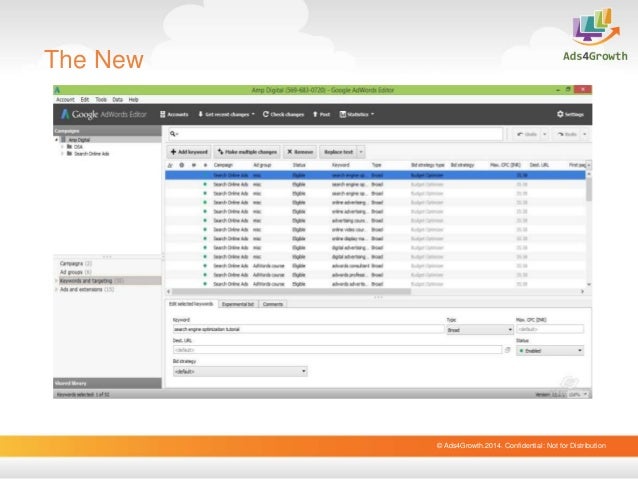
- #GOOGLE ADWORDS EDITOR TOOL HOW TO#
- #GOOGLE ADWORDS EDITOR TOOL INSTALL#
- #GOOGLE ADWORDS EDITOR TOOL PASSWORD#
- #GOOGLE ADWORDS EDITOR TOOL LICENSE#
Remember, you’re doing all of your work offline. If all of your changes are valid, you’ll see nothing but green lights in the status window that appears after the scan is complete. Click the “Check Changes” button at the bottom of the popup. You’ll see a popup that will give you a summary of your changes. Just because you’ve made some edits, that’ doesn’t mean they’re “valid.” Google AdWords might reject one or more of your changes.įortunately, you can easily check your changes to make sure that they’re valid.Īfter you’re done with your edits, click the “Check Changes” button at the top of the screen. Use extreme caution with that “Remove” button. If you want to delete an existing campaign, ad group, or keyword, highlight a row in the table and click the “Remove” button at the top of the table.īe warned: you will not be prompted with a popup asking if you’re sure that you want to perform the delete. If you want to add a new campaign, ad group, or keyword, click the “Add” button at the top of the table. Be sure to click on all the tabs to see what you can edit. Keep in mind, that lower pane is a tabbed element. If you click on a row, you can edit the info in the lower pane. It’s in a table.Įach row in the table shows an individual campaign, ad group, or keyword. You can view related details in the middle of the screen.

You can click on any one of those menu items to manage details related to them.įor example, click on “Campaigns” if you want to manage campaign info. That indicates that number of campaigns, ad groups, or keywords associated with your account.įor example, if you see “(2)” next to “Campaigns,” then there are two campaigns associated with your account. In that pane, you’ll see three clickable items: “Campaigns,” “Ad groups,” and “Keywords and targeting.”Įach one of those items will have a number in parentheses next to it. Take a look at the “Manage” pane on the lower, left-hand side of the screen. You can use it to manage pretty much everything related to your campaigns. The main user interface is fairly intuitive. Once you’re signed in, download all of your account data.
#GOOGLE ADWORDS EDITOR TOOL PASSWORD#
Enter the Gmail address and password that you usually use to sign in to AdWords, AdSense, or Gmail. When you do sign in, you’ll be challenged for your credentials. If you’re not signed in with Chrome, you can choose to sign in with the app. If you’re already signed in to your Google account on Chrome, that’s the easiest option to select. You’ll see a popup that asks if you want to sign in with Google Chrome or inside the application itself. Just click on the big “+ ADD” button towards the top of the screen. Why? Because the application doesn’t know anything about you or your AdWords campaigns.įortunately, it’s easy to download your account. Once you’ve installed the application and gone through the initial configuration steps, you’re still not quite done with downloading.
#GOOGLE ADWORDS EDITOR TOOL LICENSE#
You should see Google AdWords Editor in the menu that appears.Ĭlick on that and accept the license agreement. If you’re using Windows, click the “Start” icon in the lower, left-hand corner.
#GOOGLE ADWORDS EDITOR TOOL INSTALL#
Once the install is finished, you might have to search for the AdWords Editor application icon. In fact, during some slow moments, it might seem like the installation isn’t working. You will, however, have to wait for the installation to complete. Good news: you can download it with just a couple of clicks. You need to download AdWords Editor before you can use it. Here’s Your Step-by-Step Guide to Google AdWords Editor

#GOOGLE ADWORDS EDITOR TOOL HOW TO#


 0 kommentar(er)
0 kommentar(er)
